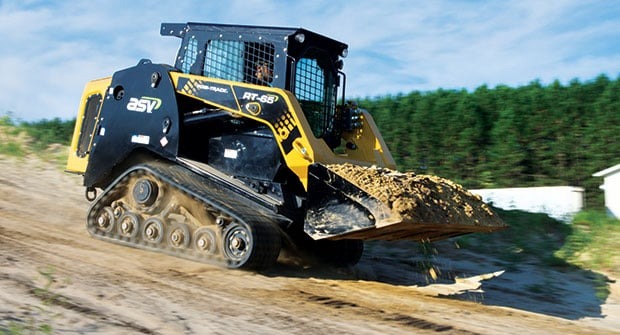Your tires or tracks under the loader do not only facilitate movement, but they determine the way the machine works, where it works, its life and the cost of keeping it going. It is a choice that affects the efficiency of the jobsite in a manner that most people do not anticipate until they have tried both. Whether you’re buying new or used, this one choice can impact your bottom line, operator comfort, and even your machine’s resale value later.
Your Jobsite Terrain Will Make the First Call
The kind of ground that you are working is one of the most immediate factors to consider. Tires work best on paved, dry or solid surfaces. They provide less rolling resistance and also a speedier travel, particularly in an urban or highway setting. However, in muddy, sandy, or snow-filled situations, tires will sink, slip, and bring you down. It is at this point that tracks come in. Having a far greater area of contact and reduced ground pressure, tracked loaders move over soft surfaces and ascend slopes with greater traction. Therefore, in case your site of work varies with the weather or soil type is erratic, then tracks might be safer.
Movement and Maneuvering
The tires provide you with maneuverability. They’re quicker on the move, turn tighter, and are easier to reposition on a busy or confined site. Tracked loaders, on the other hand, offer more controlled movement. They trade speed for traction and stability, especially on uneven or sloped terrain. In wide-open areas where constant movement isn’t necessary, tracks have a clear advantage. But if you’re considering a loader for sale for use in tighter spaces with obstacles and frequent trips, wheeled loaders are often the better choice due to their agility and speed.
Maintenance Isn’t Just About Price
The loader tires tend to be cheaper to buy and replace. When a tire is damaged, it may sometimes be repaired or replaced with a short downtime. However, tracked loaders undergo more complicated maintenance. An example, rubber tracks, are more prone to wearing out in an abrasive environment, and their replacement is also more expensive. Steel tracks have a longer life but have repair requirements of their own. A tracked loader also has more items on the undercarriage that should be frequently checked. That is why, although tracked machines might last longer in some terrains than the wheeled ones, they require additional attention during the ride.
Weight Distribution Shapes Jobsite Impact
Tracked loaders weigh less in the front and back, so they have less impact on soft or landscaped grounds. That counts in the line of employment where keeping the ground is an essential part of the work. Although tires are lighter to transport and repair, they use denser pressure by square inch. This may cause the ground to become compacted or even develop a rut- particularly when the loader is working with loads of heavy weights over wet or sensitive terrain. This is something you should weigh seriously in case you are operating in an environment where the damage of surfaces might create inconveniences or delays.
Fuel Efficiency Can Shift Based on Surface
Loaders with tires tend to be more fuel economical on smooth surfaces, and hard surfaces. There is reduced drag and resistance, which implies that the engine does not have to work hard to propel the machine between point A and point B. There is resistance when in tracks, particularly in dry or hard-packed surfaces. With time, such increased burden on the engine may be reflected at the fuel pump. But when your tires are losing grip all the time in wet or rough surfaces, then that efficiency goes away quickly. The most effective strategy to maintain the fuel expenses is to match the undercarriage with the type of surface.
Adaptability Across Jobsites Isn’t Equal
You may be tempted to compromise with a middle ground to suit projects that fluctuate between dry and flat one season to wet and rugged during another. While some loaders come with convertible undercarriages, that approach comes with trade-offs. In general, wheeled loaders are better suited for repetitive tasks on smooth surfaces. When terrain is unstable or conditions shift throughout the day, tracked loaders offer better adaptability. One is fast and versatile, the other controlled and stable. If you’re browsing heavy equipment for sale, the right choice depends on how often your jobsite conditions change and how mobile your machine needs to be between tasks.
Overview
When you need to buy your first loader or another one to replenish your fleet, the decision to buy tires or tracks must be guided by your long-term requirements. Consider the land, the work level, and wear-and-tear you can put up with. It is not the price of the initial cost but how your loader will perform year in year out. Both tires and tracks have obvious advantages, though the misuse of either can result in loss of traction, increased fuel consumption, wear and even fatigue of operators. The more it fits the more it yields.

